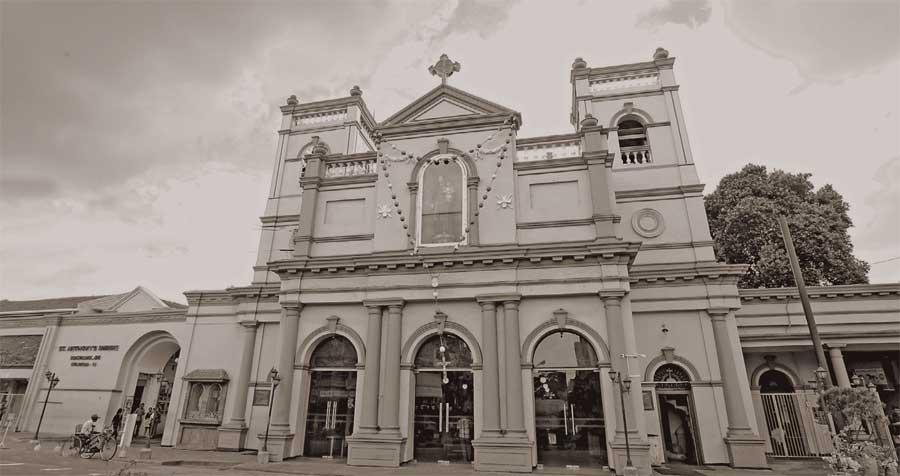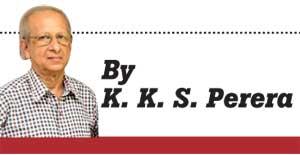Reply To:
Name - Reply Comment

Shad-varna flags fluttered in every Catholic Church this Vesak :
a show of an unprecedented unity and harmony in five centuries
Daily Mirror reported six months before the Easter Sunday carnage [on 28th Sep 2018], Archbishop of Colombo His Eminence Malcolm Cardinal Ranjith’s remarks at a daham pasal  function, “Anti religious ideologies are being filtered into the society today. We have to put them aside and safeguard religions. Rights of all people in this country are safeguarded when Buddhist culture is safeguarded,” he continued these views at the prize-giving of Kanduboda Shri Saranankara school in Delgoda. He added that Buddhism was the backbone of this country and it was a religion which had been followed by the people in this land for a long time.
function, “Anti religious ideologies are being filtered into the society today. We have to put them aside and safeguard religions. Rights of all people in this country are safeguarded when Buddhist culture is safeguarded,” he continued these views at the prize-giving of Kanduboda Shri Saranankara school in Delgoda. He added that Buddhism was the backbone of this country and it was a religion which had been followed by the people in this land for a long time.
The Cardinal who set an example to all political and religious leaders by returning the bullet-proof vehicle given to him by the government, called on the Catholic community to remain calm and act prudently in the aftermath of the Easter Sunday carnage and help officials to steer the country to safety without a backlash, a quality of true leadership. Will our politicians ever emulate that example? continuing he said, “I told the government that I can ensure my security without a bullet-proof vehicle, I am sure the God will protect me. If I am to be killed by someone, I am ready to face it as well.”
A clash between Buddhist and Catholic devotees caused unrest and anxiety on Easter Sunday in March 1883 at Kotahena. It occurred exactly opposite where the present St Anthony’s Church Kochchikade is located. Father Pagnani, the Bishop-in-charge of the Catholic Church was granted 10 acres of land by the state in 1779, and a new Cathedral was nearing completion at Kotahena.
Reverend Mohottiwatte / Migettuwatte Gunananda Thera of internationally acclaimed Panadura Vaada was the incumbent of the Kotahena Buddhist Temple which was not far from the church. An atmosphere of anxiety was developing gradually and the Catholics were determined to resist even unto death all insult to their religion.
Ven Migettuwatte Thera, the scholar monk who studied Christianity and Latin at Wesley College was completing the construction work he had started on the Temple. He informed the authorities of his intention to hold a pinkama for one and a half months on completion. The festival would end with a procession. On March 6, Rev Fr. Masilamany informed the Police that they are having their Easter processions and pointed out that there would be a clash if the Buddhists hold their processions during this time. The Police informed him that they would get the permit and also Police protection.
Catholics applied for a permit for a procession to be held on Palm Sunday March 18, and the application was lying awaiting the arrival of the Inspector-General for approval. In the meantime Ven Migettuwatte Thera, incumbent of the Buddhist temple applied for a permit for a procession on Palm Sunday and was successful in obtaining it from Mr. Hansard, Police Superintendent, which was overruled by the Inspector-General who made an order on the 17th that the Catholics had been already allowed to hold their usual procession on Palm Sunday and the Buddhists will have to forego their pageant. The permit issued to the Buddhists however, remained in force as the Inspector- General’s order did not reach the Superintendent Mr. Hansard. Mr. Tranchell, the Acting Inspector-General spoke to the Bishop who assured him that they will have no objection to a Buddhist procession being held after 12 noon on Easter Sunday.
"Shattered hopes and relations over the years between the two religious groups and in recent times over the Sabbath day [Sunday] deprivation by UNP in favour of Poya and schools take-over by SLFP governments have been reconciled in an effective manner, thanks to His Eminence Archbishop of Colombo Malcolm Cardinal Ranjith. "
As scheduled, a Buddhists’ procession under police protection entered the city on Sunday the 18th of March 1883. As it reached St. Lucia’s Corner, the main approach to the Temple and the Cathedral, some Catholics attempted to obstruct it and threw missiles at the images. The Police made a few arrests but released them the next day without taking them to Courts. Buddhists again applied for a permit for a procession to be held on Good Friday and assured that it would consist of women carrying flowers unaccompanied by drumming and sounding of horns and would take a course away from the Cathedral. After an initial refusal the Acting Inspector-General later allowed permission. As protests poured in the Superintendent was certain that this procession would lead to very serious trouble, compelling the Acting Inspector-General to cancel the permit, which fact did not get sufficient publicity.
Extra Police were sent to Kochchikade where a large crowd assembled opposite St. Anthony’s Church with the affirmed intention of preventing any procession from passing the vicinity. On 25th March, Easter Sunday additional men were moved out from Police Headquarters to Kotahena and were allowed to use their judgment about the action they were to take without the direction and guidance of seniors. Little before l p.m., church bells in the area were simultaneously rung as large bodies of men armed with clubs began to assemble at St. Lucia’s Corner. The two Sergeants were in a dilemma not knowing what to do and allowed the mob to get bolder and more self-assured. The males in the Buddhist procession were armed with sticks. There was a widespread rumour that illustrations insulting the Catholic religion would be taken in the procession; ASP Holland, a Catholic and Inspectors Marshall and Gooneratne examined to satisfy themselves that nothing offensive or insulting was taken in the procession. Inspectors Marshall and Gooneratne and l2 Constables escorted the procession while the Acting IG, Tranchell followed the procession and later overtook it and moved towards Kotahena where he saw an excited crowd of Catholics at St. Lucia’s Corner; as he could not persuade them to disperse, he collected all his men and moved to meet the procession.
"Anti religious ideologies are being filtered into the society. We have to safeguard religions. Rights of all people are safeguarded when Buddhist culture is safeguarded"
The Acting IG thought it best to disperse the Catholics and attempted to do so. He tried first to persuade them to move. Failing he ordered his men to charge on them. The mob met the charge with a shower of stones and bricks driving away the Police. As the senior cop could not handle the situation he sent a messenger requesting for military aid, and until the arrival of assistance he and his men struggled to keep the two parties apart; but only for a short while.
Soon the Buddhists and Catholics were engaged in a free for all fight. The Buddhists attempted to force a passage by driving the carts on for opponents to seize and kill a few bullock. During a pause Holland persuaded the Catholics to desist from hostility and after a Catholic Priest addressed them they began to disperse. Military guards were then placed and the area was watched till dawn. 30 injured persons were dispatched to hospital; a Buddhist named Juan Naide who had received serious injuries died in hospital. Tranchell and 12 other policemen were injured too in the conflict including a Roman Catholic Priest, named Fr. Balangero who received severe injuries. The day following Easter Monday two processions were coming into Colombo, one from Koratota and the other from Peliyagoda. Both parties were armed and ready to fight. When Tranchell with 50 men reached Kotahena there was great excitement. A Catholic Priest had been beaten up and armed men were assembling in the area. Tranchell got down more men; the procession was halted at Urugodawatte. The Buddhist monk leading the procession was convinced to turn back. Tranchell asked the military to act by upsetting the carts into the paddy fields below. The procession then turned back. On the night of the 26th the Catholic Church at Dehiwela was burnt down: It was a cadjan structure. On the same day a Buddhist procession carrying a crucifix passed through Ratmalana. The Catholics had to look on.
The Portuguese and Dutch penetrated Asian regions in the 16th century, driven by two motives - the intention to engage in trade, exploitation of resources, and secondly spreading Catholicism. The Portuguese who arrived here in 1505 used brutal terror to rule the coastal regions for 153 years, until the Dutch chased them away in 1658. The Portuguese forced Sinhala kings to renounce Buddhism and accept Catholicism in 1557: the Kings and Queens became Don Juans and Dona Catherinas. The temples [including Kelaniya temple ] were razed to the ground, ancient manuscripts were set on fire. A renowned civilisation and a gracious culture were viciously ruined.
“If instead of confining themselves purely to humanitarian work such as education, medical services to the poor and the like, they would use these activities for the purpose of proselytizing. Certainly the great faiths held by the people of India are adequate for her people. India stands in no great need of conversion from one faith to another” -- “Foreign Missionaries” Young India [1931] :Mahatma Gandhi
Every dark cloud has its own silver lining; the Easter Sunday 4/21 carnage generated an unprecedented religious and racial accord among Sri Lankans. In 2019 the coincidence of Palm Sunday falling on Sinhala and Hindu New Year made a great opportunity for all to show their unity devoid of differences and enjoy the festive season as Sri Lankans. Shattered hopes and relations over the years between the two religious groups and in recent times over the Sabbath day [Sunday] deprivation by UNP in favour of Poya and schools take-over by SLFP governments have been reconciled in an effective manner, thanks to His Eminence Archbishop of Colombo Malcolm Cardinal Ranjith.
Writer can be contacted at -- [email protected]